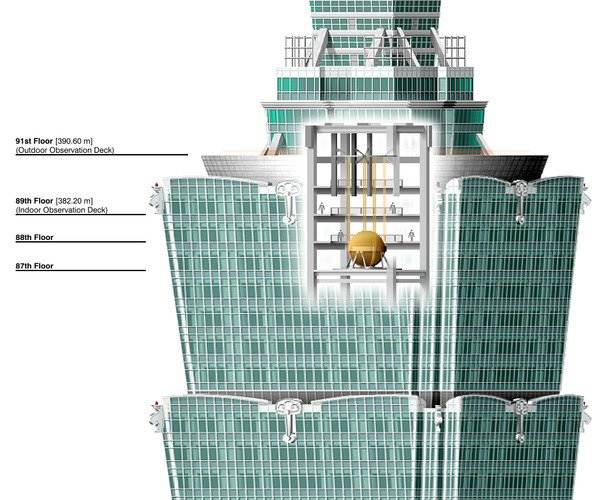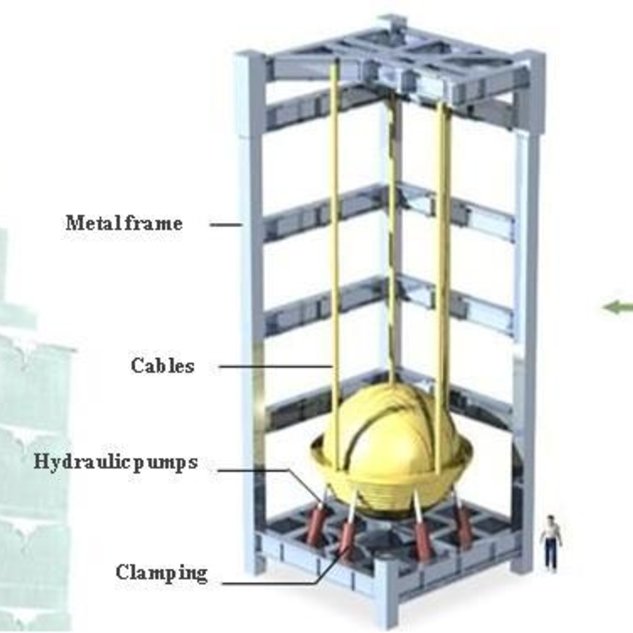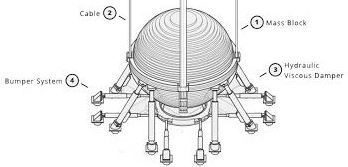In this article, we explained what is tuned mass damper, the purpose of TMD, Components of TMD, Case study of Taipai-101 building Pendulum tuned mass damper, etc. so please read the article till the end.
Before knowing about tuned mass damper, we know that various earthquake force resisting techniques.
Table of Contents
Earthquake force resisting techniques
Earthquake force resisting techniques are given below.
Base Isolation
- Energy Dissipation Method
- Bracing
- Shear wall
- Tuned mass damper
What is Tuned Mass damper?
Tuned mass damper is a device which is used to reduce the acceleration of building during earthquake.
The tuned mass damper is one type of energy dissipation method in which earthquake energy was dissipated with the help of counter sway of Tuned mass.
TMD is also known as a Harmonic absorber or seismic damper. It is mounted on the top storey of building to reduce the displacement of the building.
Also Read: 8 Aspects to Make Earthquake Proof Masonry Construction
Tuned mass damper consists spring mechanism on which the massive mass is hung. The spring mechanism has lots of advantages like spring helps mass damper to sway against in direction of movement of the building that help to make building stable during the earthquake.
Tuned mass damper is very effective techniques to resist earthquake force and in seismic area.
The tuned mass damping technique is firstly invented by Herman fram in 1901.
And recently, the pendulum Tuned mass damper is used in Taipai-101 building in Taiwan.
What is the purpose of Tune mass damper?
The main purpose of the tuned mass damper is to reduce the amplitude of a building during the earthquake or lateral forces and make the building stable.
What are the components of Tuned mass damper?
The tuned mass damper consist of Springs, Oscillation mass, and Viscous damper devices.
Pendulum Tuned mass Damper Example:
Pendulum tuned mass damper is recently used in Taipei 101 building that is the 10th tallest building in world.
The Taipei 101 tower is located in Xinyi District, Taipei, Taiwan. The architect of the Taipei 101 building name is C.Y.Lee and the Structure Designer name is shaw shieh.

Taipai 101 is a commercial type of building that is 508m tall (1667ft). The building included 101 storeys above the ground level while the 5 storey was constructed below the ground level that is a basement of Taipei 101 tower.
The construction of is started in 1998 and it was completed in 2004 that means building took 5 to 6 years to finished construction.
Also Read: What is Monolithic Construction Technology | Advantages
The construction cost of Taipei 101 building is 1.8billion dollar.
The plan area of the Taipei 101 building is 50mx50m. The design concept of the Taipei 101 building is based on Pagoda and Bamboo segmental style.
The Taipei 101 is tallest Green building in the world that is certified by LEED platinium.
The building is situated 660ft away from the fault line that means the building comes in high seismic activity zone.
Also the Soil condition at Taipei 101 building is very weak (Clay rich Soil) and the wind speed is very high like a typhoon wind.
But the building is designed in such a way that withstands against typhoon winds and the strongest earthquake.
The seismic design of building includes a central core, Trusses and bracing, a pyramid base, a Tuned mass damper, a mini damper on the spire. But we are not going to explain all seismic design components.
Pendulum Tuned mass damper of Taipei 101 Building

The pendulum-tuned mass damper of Taipei 101 building is mounted on 92 floors. It suspended from 92th floor to 87th floors.
The Ball of the tuned mass system is assembled on-site in a 125mm thick layer of Steel Plate. 41 steel plates in varying diameters are used to make it. It is welded to a steel cradle suspended from level 92 by 3’ cables, in 4 sets of 2 each.

The diameter of the ball has 18’ that is world largest tuned mass damper ball where the weight is 708 tone. The cost of this system is around 4 million dollars.
This system consist spring, viscous damping device and secondary mass attached to vibrating structure.
The Taipei tuned mass damper reduces overall building sway by 40%.


Lol you don’t explain at all HOW it reduces the amplitude. Waste of time of an article.
Please Read article carefully!